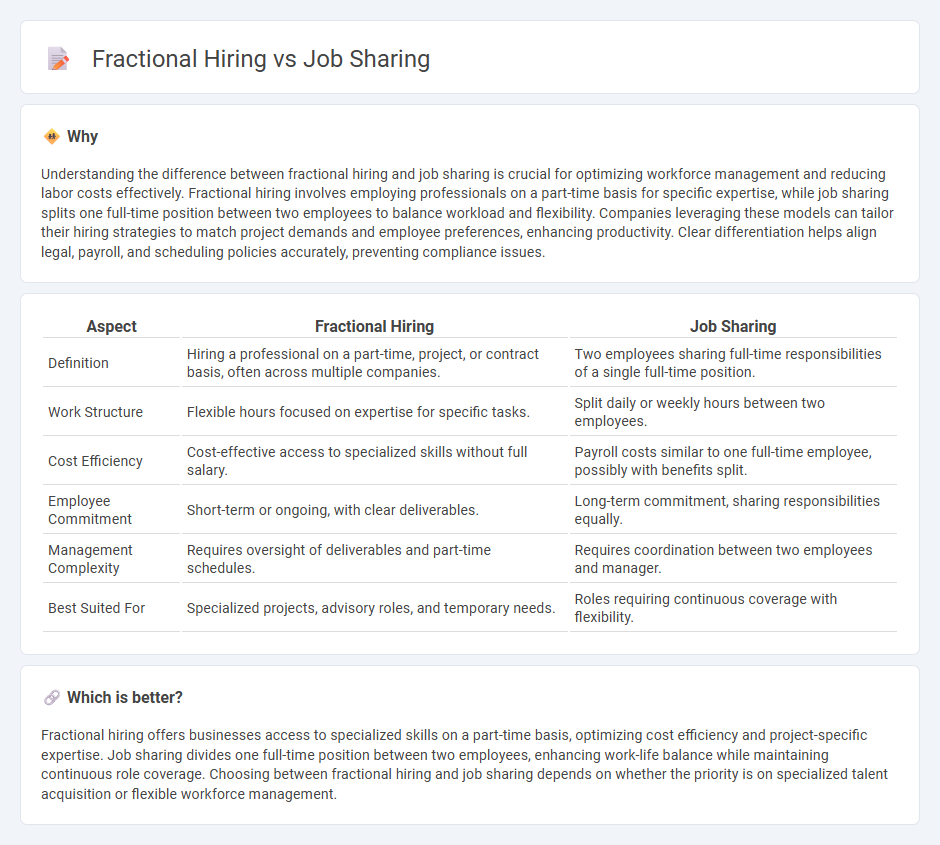
Fractional hiring involves engaging professionals on a part-time basis to focus on specific projects or roles, maximizing expertise while reducing costs. Job sharing splits a full-time position between two employees, increasing flexibility and work-life balance without sacrificing productivity. Explore the differences between fractional hiring and job sharing to find the best employment strategy for your organization.
Why it is important
Understanding the difference between fractional hiring and job sharing is crucial for optimizing workforce management and reducing labor costs effectively. Fractional hiring involves employing professionals on a part-time basis for specific expertise, while job sharing splits one full-time position between two employees to balance workload and flexibility. Companies leveraging these models can tailor their hiring strategies to match project demands and employee preferences, enhancing productivity. Clear differentiation helps align legal, payroll, and scheduling policies accurately, preventing compliance issues.
Comparison Table
| Aspect | Fractional Hiring | Job Sharing |
|---|---|---|
| Definition | Hiring a professional on a part-time, project, or contract basis, often across multiple companies. | Two employees sharing full-time responsibilities of a single full-time position. |
| Work Structure | Flexible hours focused on expertise for specific tasks. | Split daily or weekly hours between two employees. |
| Cost Efficiency | Cost-effective access to specialized skills without full salary. | Payroll costs similar to one full-time employee, possibly with benefits split. |
| Employee Commitment | Short-term or ongoing, with clear deliverables. | Long-term commitment, sharing responsibilities equally. |
| Management Complexity | Requires oversight of deliverables and part-time schedules. | Requires coordination between two employees and manager. |
| Best Suited For | Specialized projects, advisory roles, and temporary needs. | Roles requiring continuous coverage with flexibility. |
Which is better?
Fractional hiring offers businesses access to specialized skills on a part-time basis, optimizing cost efficiency and project-specific expertise. Job sharing divides one full-time position between two employees, enhancing work-life balance while maintaining continuous role coverage. Choosing between fractional hiring and job sharing depends on whether the priority is on specialized talent acquisition or flexible workforce management.
Connection
Fractional hiring involves dividing a full-time role into part-time segments, enabling multiple professionals to share responsibilities and expertise. Job sharing is a structured form of fractional hiring where two or more employees split one job's duties, hours, and benefits. Both approaches enhance workforce flexibility, optimize talent utilization, and support work-life balance initiatives.
Key Terms
Work Schedule
Job sharing divides a full-time work schedule between two employees who each work part-time hours, sharing responsibilities and tasks to maintain continuity. Fractional hiring involves hiring professionals to work part-time on specific projects or roles, often with flexible or variable hours tailored to business needs. Explore how these models optimize work schedules to improve workforce efficiency and employee satisfaction.
Responsibility Distribution
Job sharing divides a single full-time position's responsibilities and hours between two employees, promoting balanced workload and collaboration. Fractional hiring allocates specific expert tasks or leadership roles to part-time specialists across multiple projects or departments. Explore detailed comparisons to determine the best responsibility distribution strategy for your organization.
Compensation Structure
Job sharing involves two employees splitting the responsibilities and salary of a single full-time position, often resulting in pro-rated wages and benefits. Fractional hiring allocates a professional's expertise part-time across multiple projects or companies, typically with a flexible, project-based compensation structure. Explore more to understand which model best aligns with your organizational budget and talent needs.
Source and External Links
The Benefits of Job Sharing for Employers and Employees - Job sharing is a flexible work arrangement where two or more employees share the responsibilities of a single full-time job, dividing hours and duties to fit part-time schedules while maintaining the overall role requirements.
What is job sharing? - Job sharing allows two employees to share the duties of one full-time job, dividing hours, pay, and benefits pro-rata, often improving work-life balance and job satisfaction with good communication and management support.
Job sharing - Job sharing refers to two or more people working part-time to fulfill the workload of one full-time position, sharing pay, holidays, and responsibilities jointly as a team.
 dowidth.com
dowidth.com